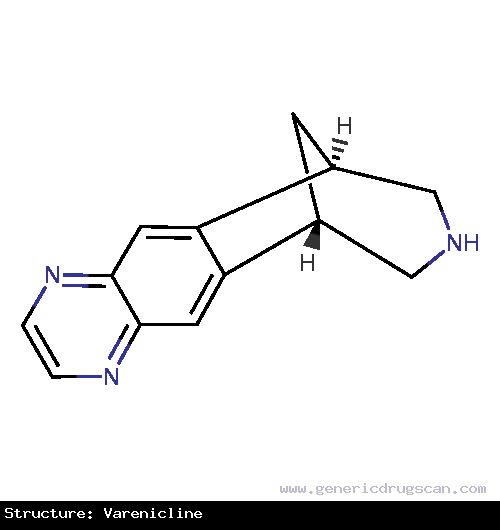Varenicline Drug: Indication, Dosage, Precaution, Side Effect , Storage, Category Type and corresponding Brands - www.genericdrugscan.com
Varenicline
Drug Status in USA : ApprovedDrug Status in Canada : Approved
pronunciation
pronounced as (var en' i kleen)
Why is this medication prescribed?
Varenicline is used along with education and counseling to help people stop smoking. Varenicline is in a class of medications called smoking cessation aids. It works by blocking the pleasant effects of nicotine (from smoking) on the brain.
How should this medicine be used?
Varenicline comes as a tablet to take by mouth. It is usually taken once or twice a day with a full glass of water (8 ounces
- 240 mL
Your doctor will probably start you on a low dose of varenicline and gradually increase your dose over the first week of treatment.
Set a quit date to stop smoking, and start taking varenicline 1 week before that date. You may continue to smoke during this first week of varenicline treatment, but make sure to try to stop smoking on the quit date you have chosen. Alternatively, you may start taking varenicline and then quit smoking between 8 and 35 days after starting treatment with varenicline.
It may take several weeks for you to feel the full benefit of varenicline. You may slip and smoke during your treatment. If this happens, you may still be able to stop smoking. Continue to take varenicline and to try not to smoke.
You will probably take varenicline for 12 weeks. If you have completely stopped smoking at the end of 12 weeks, your doctor may tell you to take varenicline for another 12 weeks. This may help keep you from starting to smoke again.
If you have not stopped smoking at the end of 12 weeks, talk to your doctor. Your doctor can try to help you understand why you were not able to stop smoking and make plans to try to quit again.
What are the precautions to be followed?
Before taking varenicline,- tell your doctor and pharmacist if you are allergic to varenicline or any other medications.
- tell your doctor and pharmacist what other prescription and nonprescription medications, vitamins, nutritional supplements, and herbal products you are taking or plan to take. Be sure to mention any of the following: anticoagulants (''blood thinners'') such as warfarin (Coumadin); insulin; other medications to help you stop smoking such as bupropion (Wellbutrin, Zyban) and nicotine gum, inhaler, lozenges, nasal spray, or skin patches; and theophylline (Theo-24). Your doctor may need to change the doses of some of your medications once you stop smoking.
- tell your doctor if you have ever had withdrawal symptoms when you tried to quit smoking in the past and if you have or have ever had heart, blood vessel, or kidney disease
- tell your doctor if you are pregnant, plan to become pregnant, or are breast-feeding. If you become pregnant while taking varenicline, call your doctor.
- you should know that varenicline may make you drowsy, dizzy, lose consciousness, or have difficulty concentrating. There have been reports of traffic accidents, near-miss accidents, and other types of injuries in people who were taking varenicline. Do not drive a car or operate machinery until you know how this medication affects you.
- ask your doctor for advice and for written information to help you stop smoking. You are more likely to stop smoking during your treatment with varenicline if you get information and support from your doctor.
What are possible side effects of this medication ?
Varenicline may cause side effects. Tell your doctor if any of these symptoms are severe or do not go away:- nausea
- constipation
- gas
- vomiting
- heartburn
- bad taste in the mouth
- increased or decreased appetite
- trouble falling asleep or staying asleep
- unusual dreams or nightmares
- headache
- swelling of the face, throat, tongue, lips, gums, eyes, neck, hands, arms, feet, ankles, or lower legs
- hoarseness
- difficulty swallowing or breathing
- rash
- swollen, red, peeling, or blistering skin
- blisters in the mouth
- pain, squeezing, or pressure in the chest
- pain or discomfort in one or both arms, back, neck, jaw, or stomach
- difficulty in moving your arms or legs
- shortness of breath
- sweating
- nausea, vomiting, or lightheadedness
- slow or difficult speech
- sudden weakness or numbness of an arm or leg, especially on one side of the body
- calf pain while walking
In clinical studies, people who took varenicline were more likely to have a heart attack, a stroke, or other serious problems with their heart or blood vessels than people who did not receive this medication. However, people who smoke also have a higher risk of developing these problems. Talk to your doctor about the risks and benefits of taking varenicline, especially if you have or ever had heart or blood vessel disease.
Varenicline may cause other side effects. Call your doctor if you have any unusual problems while taking this medication.
How to store the medication and dispose it of after its use later?
Keep this medication in the container it came in, tightly closed, and out of reach of children. Store it at room temperature and away from excess heat and moisture (not in the bathroom).
Unneeded medications should be disposed of in special ways to ensure that pets, children, and other people cannot consume them. However, you should not flush this medication down the toilet. Instead, the best way to dispose of your medication is through a medicine take-back program.
Drug Category/Class
- Nicotinic Agonists
- Drugs Used in Nicotine Dependence
- Drugs Used in Addictive Disorders
- Nervous System
- Drugs used in nicotine dependence
| Prescribed | For use as an aid in smoking cessation. |
| Weight : | 211.2624 |
| Structure | Varenicline |
 | |
| Formula | C13H13N3 |
Varenicline has 2 Brands listed
| Champix (0.5 mg) | Champix (1 mg) |
Search Generic Drugs alphabetically
